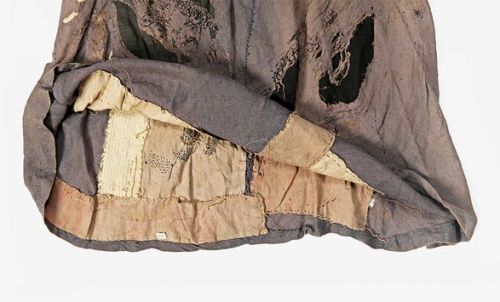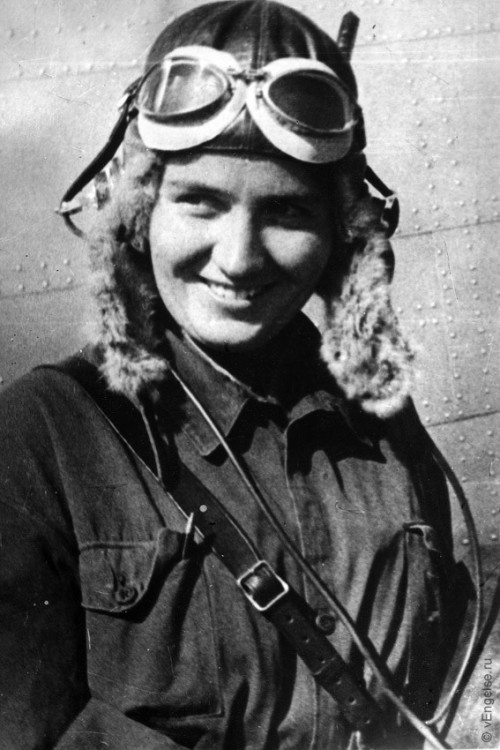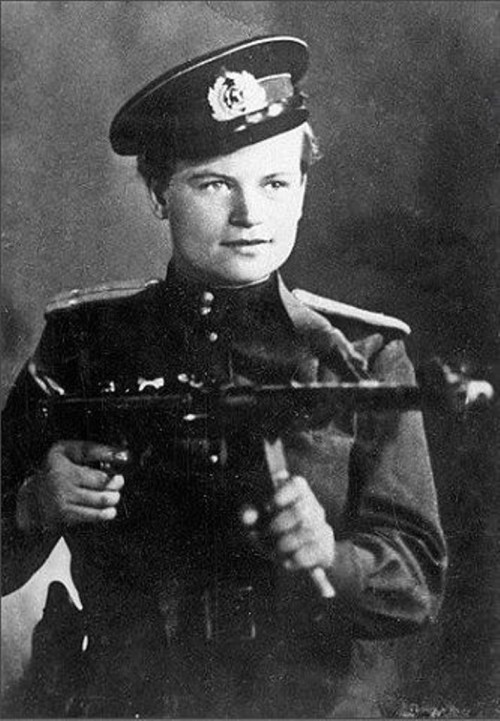#soviet history
Valentina Bukhanevich-Antonova’s summer dress, 1938/39
Antonova (1907-1993) was wearing this dress when she was arrested, and continued to wear it continuously for an entire year during her stay in three Moscow prisons. She was part of the “Great Purge” of the Stalinist era, during which millions of people, particularly political party members, were arrested for arbitrary reasons, such as being part of an opposition or nationalist group, or even sustaining brief contact with someone who had already been denounced and arrested.
Antonova’s dress shows extreme wear, but also an effort to maintain a sense of decency in her horrific surroundings. The hem and sleeves, for instance, show many attempts at patching up holes and tears, undoubtedly done on the sly. Antonova was ultimately not convicted, and released in 1939 [x].
Post link
Anti-Religion Campaigns in the Soviet Union
Karl Max called religion “the opiate of the masses,” and Soviet leaders in the 1920s and 30s took his words to heart, as these propaganda posters show. Religion was touted as a backwards institution that had no place in a Soviet Republic that strove for scientific advancement and industrialization. The Bolsheviks focused their attentions on the Orthodox Church in particular, for two reasons: it was the dominant religious body of the Tsarist era, and its use of glittering churches and artifacts gave it a bourgeois air; meanwhile, its hierarchical body of power made it a threat to the authority of the Soviet regime. Starting in 1920, churches across Russia were closed and repurposed as secular buildings, particularly for educational purposes.
Post link
March 27th 1958: Khrushchev becomes Soviet Premier
On this day in 1958, Nikita Khrushchev became head of the government of the Soviet Union. Khrushchev served as Premier of the world’s first Communist state from 1958 to 1964. He, along with Lenin and Stalin, are the only Premiers to also have been party leader simultaneously. Under Khrushchev, Russia was partially de-Stalinised, which was a core policy of the Premier who vociferously denounced his predecessor’s dangerous ‘cult of personality’. However, the accession of Khrushchev did not ease the tensions of the Cold War, and during his tenure Russia escalated its space program to compete with the United States in the ‘Space Race’. Russia had successfully launched the first satellite, Sputnik 1, in 1957, but now sought to put a man in space, which they did in 1961. It was also under Khrushchev that the Cold War came the closest to breaking out into fully fledged war, with the Cuban Missile Crisis of 1963. Khrushchev was deposed by party colleagues in 1964 and replaced by Leonid Brezhnev as First Secretary of the Communist Party and by Alexei Kosygin as Premier.
Post link
I saw a post yesterday about how a lot of Western people don’t every know about Russification policies of Tsarist Russia and the Soviet Union. This is pretty much true, as most history classes in history rarely focus on anything east of the Danube.
So, I’ve uploaded a bunch of academic articles relevant to such subjects. Be warned that this can include discussion of ethnic cleansing.
Marina Raskova (1912-1943) was a Soviet pilot, navigator, and commander who founded 3 famous female air regiments during the Second World War.
Born to a middle-class Russian family, Raskova initially had aspirations of becoming a musician, but eventually abandoned the idea to study chemistry. While working in a dye factory as a chemist she met Sergei Raskov, an engineer, who she married and had a daughter with. She changed careers in 1931 when she joined the Aerodynamic Navigation Lab of the Soviet Air Force as a draftswoman. Aged 19 in 1933 she became the first female navigator in the Air Force and the following year became the first woman to teach at the Zhukovskii Air Academy.
In 1935 she divorced from her husband and focused on her flying career. She become a famous pilot as well as a navigator, setting a number of long distance records. This included the famous ‘Flight of the Rodina’ covering 6000km from MoscowtoKomsomolsk, which she conducted with two other female pilots, Polina OsipenkoandValentina Grizodubova. However the flight ran into difficulties at the end of its 26 and a half hour journey when poor visibility hampered the landing. As the navigator’s pit was vulnerable in crash landings, Raskova bailed out with a parachute while the two pilots completed the landing. She survived with no water and almost no food for 10 days before she found her way to landing site and reunited with her team. All 3 women were decorated with the ‘Hero of the Soviet Union’ award, the first women ever to receive it.
With the outbreak of World War 2 the Soviet Union was in need of pilots and many women volunteered. However while there were no formal restrictions on Soviet women in the military, many found their applications were denied or mysteriously delayed. Raskova proposed the creation of women’s aviation units and used her celebrity status to propose the idea directly to the Soviet leader Joseph Stalin. Following a speech by Raskova in September 1941 calling for women pilots to be welcomed into the war, Stalin ordered the creation of 3 new air regiments, the 586th Fighter Aviation Regiment, the 125th Guards Bomber Aviation Regiment, and the 46th Taman Guards Night Bomber Aviation Regiment, dubbed The Night Witches. These regiments were entirely formed of women, from the pilots to the engineers to the support staff. Each regiment contained around 400 women, most of them in their early twenties, who completed 4 years’ worth of training in a matter of months.
Raskova personally took command of the 125th Bomber Regiment, for which she obtained the very best equipment available, including the state-of-the-art Petlyakov Pe-2 bombers, which caused some resentment from male units. The 125th regiment went on to fly 134 missions over the course of the war, dropping over 980 tons of bombs.
Raskova herself was killed on January 4th 1943, while attempting to lead two other Pe-2’s to a safe airfield. She was forced into making a forced landing on the Volga Bank, which resulted in the deaths of the entire bomber crew. Raskova received the first state funeral of the war and her ashes were buried in the Kremlin Wall beside those of fellow pilot, Polina Osipenko. She was posthumously awarded the Order of Patriotic War 1st Class and the regiments she created continued to serve for the duration of the war.
Post link
Yevdokiya Zavaliy was a Soviet nurse, soldier and marine commander who fought in World War 2.
Born in 1924, Zavaliy was raised in a small village in the Mykolaiv region of Ukraine, where she worked on a farm. She was brutally exposed to the outbreak of World War 2 when enemy planes bombed her village and in the aftermath she treated injured soldiers by ripping up bed sheets from her home to make improvised bandages. The event left such an impression on her that she persuaded the commander of a cavalry regiment to take her with them to the front line, claiming to be 18 years old when she was in fact 16.
Zavaliy started serving with the regiment as a nurse, but during this time she learned to shoot rifles, pistols and machine guns. She also became directly involved in conflicts, taking a wound to the abdomen during the retreat at Khortytsia island and saved the life of a wounded officer by dragging him to safety. She was awarded the Order of the Red Star for her bravery, but this was only to be the first decoration she would receive.
One day an officer mistook Zavaliy for a man as she wore soldier’s clothes and her head had been shaved to remove lice. The officer ordered her to join a group of soldiers headed to the front line. Zavaliy decided to go along with the mistake and two hours later she took part in a battle near Goryachy Kluch with the 6th Airborne Brigade. She continued to serve in numerous battles under her new male identity and following her capturing of a German officer in combat she was appointed to commander of a reconnaissance squad. When Soviet troops were starving near Mozdok in late 1942, Zavaliy mounted a daring night raid across a river to a German camp, where she stole ammunition and provisions before sailing away on a raft.
The following year Zavaliy was a sergeant serving in the Kuban region when her company was surrounded during a heavy firefight and the company commander was killed. Seeing her fellow soldiers faltering Zavaliy took command, shouting for the men to follow her and leading them in a furious counter-attack which broke the enemy and sent them into retreat. The battle left her seriously injured and during her treatment the doctors discovered that she was a woman. Zavaliy expected to be dismissed and return to nursing, however in light of her many achievements she was allowed to stay in the army and in October 1943 she was promoted to commander of a submachine gunner platoon.
While the men of her platoon were initially reluctant to follow the orders of a teenage girl, Zavaliy quickly won their respect. The platoon was repeatedly deployed to the forefront of the most intense fighting, where Zavaliy led her men in daring attacks on German lines, taking part in the defense of the Caucasus, the battle for Crimea and ultimately the Soviet expansion across Eastern Europe. She became so feared by German soldiers that they nicknamed her ‘Frau Black Death’. Twice she was believed to have been killed in action but both times she returned unscathed. In her military career she was wounded a total of 4 times and received approximately 40 medals of honour.
Zavaliy was eventually discharged from the army in 1947 and traveled to Kiev where she married and had 2 children. She spent much of her life working as the manager of a grocery store but also toured many Soviet cities and army bases where she was celebrated as a military hero. She died in Kiev in 2010.
Post link
Klavdiya Kalugina was one of the youngest Soviet snipers who fought during World War 2.
Born in 1926, Kalugina was aged 15 when Germany invaded the Soviet Union in 1941, at which time she was working in a munitions factory. Shortly after the invasion she joined the Komsomol (Communist Youth League) and in 1943 she was accepted into a Komsomol sniper school. Although she initially struggled with the training, Kalugina credited her graduation from the school to the patience of her squad commander.
Kalugina was sent to the front lines in March 1944 where she joined the 3rd Belorussian Front. Aged 17, she operated in a sniper/spotter team with a girl who she had trained with, Marusia Chikhvintseva. Her usual weapon was a Mosin-Nagant rifle with a PU scope, with which she engaged enemies at distances from as close as 200 metres to as far as 1200. She described her objective as eliminating key targets such as enemy commanders and machine gun emplacements, making one shot per day from a heavily camouflaged position and then returning to base at night.
Kalugina survived the war, although her partner, Chikhvintseva, did not. There is no account of her life following the end of the war.
An interview with Kalugina describing her experiences of her wartime experiences in detail can be read here.
Post link
Thebizarre history of Birobidzhan could not be left to a more capable custodian than Masha Gessen.
Post link
Hi everyone!
Today I received this watch - as a little New Year’s gift for myself - a Soviet Raketa straight from the 80s.
And here’s a little story about it :)

The watch “Raketa”-“Zero” ( rus. Большой ноль, “Big Zero”) of the Petrodvorets Watch Factory appeared in 1984-1985.
By order of the All-Union Society of the Blind, a watch design with a white dial, large contrasting numbers and wide hands was developed for visually impaired people.
By 1986, the release of this model was planned to be discontinued, since enough watches were produced for the Society, and ordinary citizens didn’t need them. Perestroika has begun.
For the first time this design became popular thanks to the General Secretary of the CPSU Central Committee Mikhail Gorbachev. During an international summit in Italy, he was asked to explain what “perestroika" means. Gorbachev just pointed at his Raketa “Big Zero" watch and said: “It’s like on my watch: the Russians want to start everything from ground zero!”

The phrase immediately made headlines in Italian newspapers. That’s how the legend of “Big Zero" began!

Italian entrepreneurs came to the Petrodvorets Watch Factory. The watch with “zero” delighted them and they made a huge order for themselves, the demand for everything related to “perestroika” in the West was very great at that time.
From that moment on, the production of all kinds of exterior designs of the “zero” began at the PWF: on the theme of perestroika (with images of Soviet symbols), pocket watch, in classic cases, with black dials and even with a holographic film on the dial.




@elenatria@connihd@progressi9@legasovas@litttlesilkworm@odense@bewareofdragon@art-is-a-malady@johnlockismyreligion@cinemaocd

“Jonathan Dimbleby’s masterly account of the most monumental conflict in human history is an impressive achievement. The vast scale on which Barbarossa was fought, the complex ever-shifting politics, and the rich mix of personalities surrounding Hitler, Stalin, Churchill and Roosevelt, are woven into a fast-paced, gripping read. But it is the wealth of eyewitness evidence detailing the unspeakable horror and hardship, the apocalyptic scenes and sheer savagery of Barbarossa that leaves the most lasting impression.”

“Encyclopedic and compelling, this meticulously researched book synthesizes the latest scholarship on the Soviet Afghan war. With original survey data and the comprehensive analysis of a decade of Soviet media and public opinion, Yaacov Ro'i shows clearly how Soviet participation in the Afghan war undermined faith in Soviet ideals and accelerated the Soviet collapse.”

Vasilii Vasil’evich Mansurov was born in December 1901 in the village of Kukarka, Ianskii uezd, Viatskaia Gubernia into the family of a Russian baker. He completed an rural elementary school and from 1915-1917 the boy worked at a private shop in the village of Kukarka. From 1917-1918, Mansurov was an unskilled laborer in a private enterprise. From 1918-1919, he was assistant machinist/smith in repair shops.
He served in the Red Army and was an active participant in the Civil War. After demobilization Mansurov worked in the city of Sovetsk as an instructor of the Komsomol from 1923-1924. He then went to work as the executive secretary of the Sovetskii Volkom of the Komsomol and then a propagandist in the Sovetskii Party Volkom from 1924-1928. It was at this time (1927) that he joined the party. Mansurov worked as the chairman of the board of the credit partnership from 1928-1930. Then he became the head of propaganda department of the Sovetskiidistrict party committee from 1930-1931. Then Mansurov moved to the village of Kiknur whereupon he took up the post of head of the agitmass department of the Kiknurskii raikom in 1931. He then became the responsible editor of the district newspaper, a post he held from 1931-1934. From 1934-1937, Mansurov worked as the chairman of the RIK. He was removed from that post by the obkom (likely as a result of accusations of mismanagement and supporting Kulaks). Mansurov was transferred back to Sovetsk where he worked as the director of the trade department from 1937-1938. He was then head of the city soviet’s housing department in 1938. He worked as a teacher at the regional school for collective farm personnel from 1938-1939. And then he was the deputy and later executive editor of the district newspaper “The Way of Ilyich” from 1939-1942. Vasilii Mansurov was then drafted into the army and was sent to the front. He was killed in battle on Febuary 19, 1942.
Politicheskie Lidery, p 312.
U.S. President Ronald Reagan and Soviet General Secretary Mikhail Gorbachev signing the INF Treaty in the East Room at the White House in 1987
The Intermediate-Range Nuclear Forces Treaty (INF) is a 1987 agreement between the United States and the Soviet Union. Signed in Washington, D.C. by U.S. President Ronald Reagan and General Secretary Mikhail Gorbachev on 8 December 1987, it was ratified by the United States Senate on 27 May 1988 and came into force on 1 June of that year. The treaty is formally titled The Treaty Between the United States of America and the Union of Soviet Socialist Republics on the Elimination of Their Intermediate-Range and Shorter-Range Missiles.
Post link












